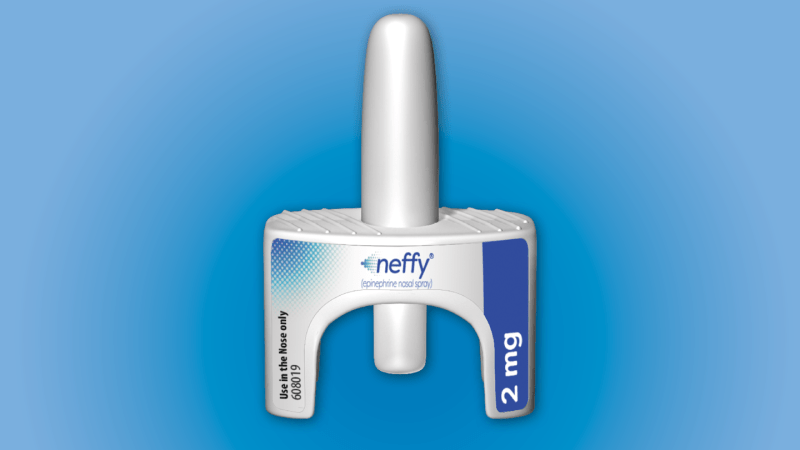
Extreme Climate Survey
Scientific news is collecting questions from readers about how to navigate our planet’s changing climate.
What do you want to know about extreme heat and how it can lead to extreme weather events?
The hormone epinephrine is the therapy used for anaphylaxis, a potentially life-threatening reaction that can occur after exposure to a food, drug, or insect venom in those who are allergic. The exaggerated immune system response during anaphylaxis leads to low blood pressure and difficulty breathing, among other symptoms. From 2004 to 2016, there were about two cases of anaphylaxis per 1,000 people per year nationally, with 25 percent of anaphylaxis reactions occurring in children 16 and older. It is rare for anaphylaxis to lead to death, but there is no way to predict when it might happen.
The method of giving epinephrine has long been a needle: a shot or a device called an auto-injector. For people at risk of anaphylaxis, the medical recommendation is to use epinephrine at the first signs of a reaction. Symptoms tend to resolve quickly with one dose. A research review estimated that about 1 in 10 anaphylactic reactions are treated with more than one dose. Auto-injectors come as a two-pack, so people at risk can carry two doses.
But studies have found that some people do not use epinephrine during a severe allergic reaction. Some are afraid of needles and some parents worry about hurting their children when they give a dose. Having a needle-free option that’s easy to use “is a game changer,” says immunologist Theresa Bingemann of the University of Rochester Medical Center in New York.
Scientific news spoke to two experts about what happens during an allergic reaction, how epinephrine works, and why neffy can help fill a problematic gap in healthcare.
What is happening in the body during anaphylaxis and how does epinephrine stop the reaction?
Anaphylaxis can occur within minutes of exposure to an allergen. Certain immune cells in the body release the chemical histamine and other compounds that lead to, among other harms, low blood pressure, narrowing of the airways, and leaky blood vessels. People may develop hives or swelling, have trouble breathing, wheezing, cough, nausea, vomiting or fainting. Patients have described anaphylaxis as “a sense of impending doom,” says pediatric allergist Carla Davis of Baylor College of Medicine and Texas Children’s Hospital in Houston. “They feel like something really bad is going on.”
Epinephrine is also called adrenaline, known as the “fight or flight” hormone. It counteracts anaphylaxis by constricting blood vessels to raise blood pressure and relaxing airways to restore easy breathing, among other actions. Medical guidelines recommend using epinephrine at the onset of anaphylaxis symptoms, especially if the signs appear in two different parts of the body, such as the skin and the lungs. The earlier people are treated, the sooner they feel better, Bingemann says. “We usually tell people: When in doubt, treat.”
Will the nasal spray work if a person has breathing problems?
Epinephrine in the nasal spray is not meant to be inhaled. The drug is absorbed in the nasal mucosa. It’s the same as naloxone spray, Narcan. This medicine is given to people who experience an opioid overdose, which also causes breathing difficulties.
Each neffy spray contains one dose. The instructions call for inserting the nose into one nostril until the fingers can touch the nose and then pressing the plunger. If necessary, a second dose would go into the same nostril.
How was the nasal spray tested?
ARS Pharmaceuticals conducted several clinical trials to compare the absorption and action of epinephrine via nasal spray, auto-injector, and injection. Blood epinephrine concentrations reached comparable levels at a similar time after birth by all three methods, the research found. The increases in blood pressure and heart rate produced by the three methods were also similar. The results were held in another study that compared self-administration of neffy with an injection of epinephrine by a health care provider.
In a study of neffy in children weighing 30 pounds or more, the concentration of epinephrine in the blood matched that seen in adults, according to the FDA.
What kind of impact might the availability of epinephrine nasal spray have on the treatment of anaphylaxis?
“It’s a big deal,” Davis says. In her experience, people can be very hesitant to treat anaphylaxis with epinephrine. Some people are afraid of needles or feel anxious about administering epinephrine. Some people are not sure how to use auto injectors. Cost has also been an issue, with the list price for a widely used two-pack of auto-injectors reaching around $600 in 2016.
Many episodes of anaphylaxis occur in the community, outside of medical settings. A 2018 study in Annals of Allergy, Asthma and Immunology found that more than 50 percent of adults and 30 percent of children reported at least one severe allergic reaction in which an epinephrine auto-injector would have helped but was not used. “It’s a huge gap in care,” Davis says.
Multiple episodes of untreated anaphylaxis can affect people’s quality of life, Davis says. “What I see is anxiety in children, in adults, staying away from social situations.”
Epinephrine “only works if you have it and use it,” says Bingemann, and the best device is the one that works best for an individual. The nasal spray offers a choice that can give people more confidence in their ability to handle a reaction because they don’t have to stick themselves with a needle, she says. If the new method helps more people use epinephrine right away, “that would be great, and I hope that’s what we’ll see eventually.”
#People #food #allergies #treat #severe #reactions
Image Source : www.sciencenews.org